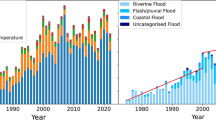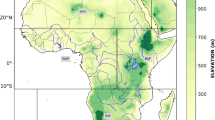Abstract
Dengue is among the largest public health problems in Brazil. Reported dengue cases via DATASUS were correlated with reanalysis data from NCEP (rainfall and air temperature) and Brazil’s population data (2000 and 2010) from 1994 to 2014. The aim of this study was to evaluate relational patterns between climate variables together with population data from the last census and reported cases of dengue in Brazil from 1994 to 2014 by using statistical techniques. Several statistical methods [descriptive and exploratory statistics; simple and multiple linear regressions; Mann–Kendall (MK), Run, and Pettit nonparametric tests; and multivariate statistics via cluster analysis (CA)] were applied to time series. The highest percentages of Dengue cases were in Brazil’s Southeast (47.14%), Northeast (29.86%), and Central West (13.01%). Upon CA of the Brazilian regions, three homogeneous dengue groups were formed: G1 (North and Central West), G2 (Southeast and Northeast), and G3 (South). Run testing indicated that the time series is homogenous and persistence free. MK testing showed a nonsignificant trend of increase of dengue cases in 23 states with positive trends and in four states with negative trends of Brazil. A significant increase in the magnitude of dengue at the regional level was recorded in the North, Southeast, South, and Central West regions. Statistical methods showed that dengue variability in Brazil is cyclical (2- to 3-year cycles), but not repetitive of El Niño-Southern Oscillation (ENSO) in the moderate, strong, and neutral categories. ENSO interferes with the action of weather systems, changing or intensifying rainfall and air temperatures in Brazil. The population increase in recent decades and the lack of effective public policies together with the action of ENSO contributed to the increase in dengue cases reported in Brazil.





Similar content being viewed by others
References
Ahmed, S. I., Rudra, R., Dickinson, T., & Ahmed, M. (2014). Trend and periodicity of temperature time series in Ontario. American Journal of Climate Change, 3, 272–288.
Barcellos, C., & Lowe, R. (2014). Expansion of the dengue transmission area in Brazil: The role of climate and cities. Tropical Medicine and International Health, 19, 159–168.
Bhatt, S., Gething, P. W., Brady, O. J., Messina, J. P., Farlow, A. W., Moyes, C. L., Drake, J. M., Brownstein, J. S., Hoen, A. G., Sankoh, O., Myers, M. F., George, D. B., Jaenisch, T., William Wint, G. R., Simmons, C. P., Scott, T. W., Farrar, J. J., & Hay, S. I. (2013). The global distribution and burden of dengue. Nature, 496, 504–507.
Câmara, F. P., Gomes, A. F., Santos, G. T., & Câmara, D. C. P. (2009). Clima e epidemias de dengue no Estado do Rio de Janeiro. Revista da Sociedade Brasileira de Medicina Tropical, 42, 137–140.
Campbell, L. P., Luther, C., Moo-Llanes, D., Ramsey, J. M., Danis-Lozano, R., & Peterson, A. T. (2015). Climate change influences on global distributions of dengue and chikungunya virus vectors. Phil. Trans. R. Soc. B, 370, 20140135. https://doi.org/10.1098/rstb.2014.0135.
Chaves, R. R., & Cavalcanti, I. F. A. (2001). Atmospheric circulation features associated with rainfall variability over southern Northeast Brazil. Monthly Weather Review, 129, 2614–2626.
Colón-González, F. J., Fezzi, C., Lake, I. R., & Hunter, P. R. (2013). The effects of weather and climate change on dengue. PLoS Neglected Tropical Diseases, 7(11), e2503. https://doi.org/10.1371/journal.pntd.0002503.
Costello, A., Abbas, M., Allen, A., Ball, S., Bellamy, R., Friel, S., Grace, N., Johnson, A., Kett, M., Lee, M., Levy, C., Maslin, M., McCoy, D., McGuire, B., Montgomery, H., Napier, D., Pagel, C., Patel, J., Oliveira, J. A. P., Redclift, N., Rees, H., Rogger, D., Scott, J., Stephenson, J., Twigg, J., Wolff, J., & Patterson, C. (2009). Managing the health effects of climate change. Lancet, 373, 1693–1733.
CPTEC-Centro de Previsão do Tempo e Estudos Climáticos (2015). ENOS. http://enos.cptec.inpe.br/. Acesso em: 04 de fevereiro.
DATASUS-Departamento de Informática do SUS (2015). Informações de Saúde. http://www2.datasus.gov.br/DATASUS/index.php. Acesso em: 13 março.
Everitt, B. S., & Dunn, G. (1991). Applied multivariate analysis (Vol. 400). London: Edward Arnold.
Grimm, A. M. (2003). The El Niño impact on the summer monsoon in Brazil: Regional processes versus remote influences. Journal of Climate, 16, 263–280.
Groppo, J. D., Moraes, J. M., Beduschi, C. E., & Martinelli, L. A. (2005). Análise de Séries Temporais de Vazão e Precipitação em Algumas Bacias do Estado de São Paulo com diferentes graus de intervenções antrópicas. Geociências24, 181–193.
Hirsch, R. M., & Slack, J. R. (1984). A nonparametric trend test for seasonal data with serial dependence. Water Resources Research, 20, 727–732.
Husain, T., & Chaudhary, J. R. (2008). Human helath risk assessment due to global warming – A case study of the Gulf countries. International Journal of Environmental Research Public Health, 5, 204–212.
IBGE–Instituto Brasileiro de Geografia e Estatística. Área Territorial Oficial e Censo Demográfico Populacional do Brasil. Disponível em: http://www.ibge.gov.br/home/geociencias/cartografia/default_territ_area.shtm. Acesso em: 02 fev 2015.
Kalnay, E., Kanamitsy, M., Kistler, R., Collins, W., Deaven, D., Gandin, L., Iredell, M., Saha, S., White, G., Woollen, J., Zhu, Y., Chelliah, M., Ebisuzaki, W., Higgins, W., Janowiak, J., Mo, K. C., Ropelewski, C., Wang, J., Leetmaa, A., Reynolds, R., Jenne, R., & Joseph, D. (1996). The NCEP/NCAR reanalysis 40-year project. Bulletin of the American Meteorological Society, 77, 437–471.
Kendall, M. G. (1975). Rank correlation methods (4th ed.). London: Charles Griffin.
Liao, C.-M., Huang, T.-L., Lin, Y.-J., You, S.-H., Cheng, Y.-H., Hsieh, N.-H., & Chen, W.-Y. (2015). Regional response of dengue fever epidemics to interannual variation and related climate variability. Stochastic Environmental Research and Risk Assessment, 29(3), 947–958. https://doi.org/10.1007/s00477-014-0948-6.
Liebmann, B., Kiladis, G. N., Marengo, J. A., Ambrizzi, T., & Glick, J. D. (2009). Submonthly convective variability over South America and the South Atlantic convergence zone. Journal of Climate, 12, 1877–1891.
Lowe, R., Bailey, T. C., Stephenson, D. B., Jupp, T. E., Graham, R. J., Barcellos, C., & Carvalho, M. S. (2012). The development of an early warning system for climate-sensitive disease risk with a focus on dengue epidemics in Southeast Brazil. Statistics in Medicine, 32, 864–883.
Lyra, G. B., Oliveira-Júnior, J. F., & Zeri, M. (2014). Cluster analysis applied to the spatial and temporal variability of monthly rainfall in Alagoas state, northeast of Brazil. International Journal of Climatology, 34, 3546–3558.
Magalhães, G. B., & Zanella, M. E. (2015). The variability climate and frequency of dengue in Fortaleza, CE, Brazil. REDE – Revista Eletrônica do PRODEMA, 9, 35–50.
Mann, H. B. (1945). Non-parametric test against trend. Econometrica, 13, 245–259.
Marques, R. F. C., & Rao, V. B. (2012). Interannual variations of blockings in the southern hemisphere and their energetics. Journal of Geophysical Research, 105, 4625–4636.
Marzochi, K. B. F. (2004). Dengue endêmico: o desafio das estratégias de vigilância. Revista da Sociedade Brasileira de Medicina Tropical, 37, 413–415.
Massad, E., Coelho, M., & Leuda, O. (2011). The influence of climate variables on dengue in Singapore. International Journal of Environmental Health Research, 21(6), 415–426. https://doi.org/10.1080/09603123.2011.572279.
Massad, E., Coutinho, F. A. B., Ma, S., & Burattini, M. N. (2010). A hypothesis for the 2007 dengue outbreak in Singapore. Epidemiology & Infection, 138(7), 951–957. https://doi.org/10.1017/S0950268809990501.
Mendes, M. C. D., Cavalcanti, I. F. A., Trigo, R. M., Mendes, D., Dacamara, C. C., & Aragão, M. R. S. (2009). Episódios de Bloqueios no Hemisfério Sul: Comparação Entre Reanálises do NCEP/NCAR e Modelo HADCM3. Revista Brasileira de Meteorologia, 24, 262–275.
Minuzzi, R. B., Sediyama, G. C., Barbosa, E. M., & Melo Júnior, J. C. F. (2007). Climatologia do Comportamento do Período Chuvoso da Região Sudeste do Brasil. Revista Brasileira de Meteorologia, 22, 338–344.
Montgomery, D. C., Peck, E. A., Vining, G. G. 2001. Introduction to Linear Regression Analysis. 3. ed. Londres: Wiley-Interscience, 641 p.
Morin, C. W., Comrie, A. C., & Ernst, K. (2013). Climate and dengue transmission: Evidence and implications. Environmental Health Perspectives, 121, 1264–1272.
Murray, N. E. A., Quam, M. B., & Wilder-Smith, A. (2013). Epidemiology of dengue: Past, present and future prospects. Clinical Epidemiology, 5, 299–309.
Oliveira, R. M., & Valla, V. V. (2001). As condições e as experiências de vida de grupos populares no Rio de Janeiro: repensando a mobilização popular no controle do dengue. Caderno de Saúde Pública, 17, 77–88.
Pettitt, A. N. (1979). A non-parametric approach to the changepoint problem. Applied Statistics, 28, 126–135.
Pohlert, T. (2016). Non-parametric trend tests and change-point detection. CC BY-ND, 4.
R Development Core Team. R: A language and environment for statistical computing. R Foundation for Statistical Computing, Vienna, Austria, 2019. http://www.R-project.org.
Reboita, M. S., Gan, M. A., Rocha, R. P., & Ambrizzi, T. (2010). Regimes de Precipitação na América do Sul: Uma Revisão Bibliográfica. Revista Brasileira de Meteorologia, 25, 185–204.
Shepard, D. S., Undurraga, E. A., & Halasa, Y. A. (2013). Economic and disease burden of dengue in Southeast Asia. PLoS Neglected Tropical Diseases, 7(2), e2055. https://doi.org/10.1371/journal.pntd.0002055.
Sophie, O. V., van Benthem, B. H. B., Khantikul, N., Burghoorn-Maas, C., Panart, K., Oskam, L., Lambin, E. F., & Somboon, P. (2006). Multi-level analyses of spatial and temporal determinants for dengue infection. International Journal of Health Geographics, v, 5(5), 1–16. https://doi.org/10.1186/1476-072X-5-5.
Teixeira, M. G., Siqueira, J. B., Jr., Ferreira, G. L., Bricks, L., & Joint, G. (2013). Epidemiological trends of dengue disease in Brazil (2000–2010): A systematic literature search and analysis. PLoS Neglected Tropical Diseases, 7(12), e2520.
Teodoro, P. E., Oliveira-Júnior, J. F., Cunha, E. R., Correa, C. C. G., Torres, F. E., Bacani, V. M., Gois, G., & Ribeiro, L. P. (2015). Cluster analysis applied to the spatial and temporal variability of monthly rainfall in Mato Grosso do Sul state, Brazil. Meteorology and Atmospheric Physics, 1, 1–13.
Viana, D. V., & Ignotti, E. (2013). A ocorrência da dengue e variações meteorológicas no Brasil: revisão sistemática. Revista Brasileira de Epidemiologia, 16, 240–256.
Ward, J. H. (1963). Hierarchical grouping to optimize an objective function. Journal of the American Statistical Association, 58, 236–244.
WHO-World Health Organization (2014). Dengue and severe dengue. Fact sheet No. 117. http://www.who.int/mediacentre/factsheets/fs117/en/. Acesso em: Julho/2014.
Yue, S., Pilon, P. J., Phinney, B., & Cavadias, G. (2002). The influence of autocorrelation on the ability to detect trend in hydrological series. Hydrological Processes, 16, 1807–1829.
Zeri, M., Oliveira-Júnior, J. F., & Lyra, G. B. (2011). Spatiotemporal analysis of particulate matter, sulfur dioxide and carbon monoxide concentrations over the city of Rio de Janeiro, Brazil. Meteorology and Atmospheric Physics, 113, 139–152.
Acknowledgments
The authors acknowledge the Departamento de Informática do SUS–Sistema Único de Sáude (DATASUS), Instituto Brasileiro de Geografia e Estatística and National Centers for Environmental Prediction/National Center for Atmospheric Research by the data availability of reported dengue cases, population in Brazil and reanalysis data.
Author information
Authors and Affiliations
Corresponding author
Additional information
Publisher’s note
Springer Nature remains neutral with regard to jurisdictional claims in published maps and institutional affiliations.
Rights and permissions
About this article
Cite this article
de Oliveira-Júnior, J.F., Gois, G., da Silva, E.B. et al. Non-parametric tests and multivariate analysis applied to reported dengue cases in Brazil. Environ Monit Assess 191, 473 (2019). https://doi.org/10.1007/s10661-019-7583-0
Received:
Accepted:
Published:
DOI: https://doi.org/10.1007/s10661-019-7583-0




